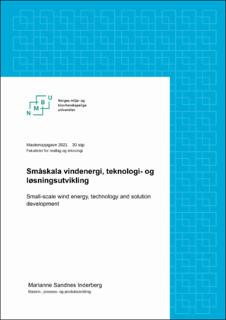| dc.contributor.advisor | Bøe, Jan Kåre | |
| dc.contributor.author | Inderberg, Marianne Sandnes | |
| dc.date.accessioned | 2022-03-22T09:37:31Z | |
| dc.date.available | 2022-03-22T09:37:31Z | |
| dc.date.issued | 2021 | |
| dc.identifier.uri | https://hdl.handle.net/11250/2986727 | |
| dc.description.abstract | Det er en enighet blant verdens klimaforskere at menneskeskapte klimagassutslipp er i ferd med å forårsake endringer klimaet som vil medføre alvorlige konsekvenser for menneskeheten og naturen. FNs klimarapport, publisert 9. august 2021, konstaterer det faktum at det er kopling mellom klimagassutslipp og klimaendringer. Følgelig har klimapolitikken satt en rekke kraftige mål for fremtiden for å bremse opp utviklingen og endringene i klimaet. For at disse målene skal nås, må energiforbruket legges om gjennom å erstatte fossil energi med fornybar energi.
En energikilde som har blitt brukt i flere tusen år, og som det i dag er et stort og økende fokus på i forbindelse med kraftproduksjon, er vindenergi. I dag finnes det vindturbiner som omdanner vindenergi til elektrisk energi i et vidt spekter størrelser, fra de minste vindturbinene, også kaldt «mikrovindturbiner» som produserer så lite som under 1,0 kW til 50 kW, til de aller største vind-turbinene som produserer omkring 15 MW. Det satses stort på kjempeturbiner, spesielt i sammenheng med havvind. Disse turbinene leverer enormt mye strøm, men ikke uten ulemper.
De store vindturbinparkene er kraftige naturinngrep, og må plasseres strategisk med hensyn til vindressurs og samtidig med hensyn til omgivelsene. De store vindturbinene er en trussel for dyreliv, spesielt fugler, de er visuelt forstyrrende i naturen og de produserer akustisk støy som over tid kan være skadelig for mennesker som bor i nærheten. Derfor satses det nå stort på havvind og flytende vindkraftverk. Disse kraftverkene forstyrrer mennesker, natur og dyreliv i mindre grad enn de landbaserte vindkraftverkene, og samtidig er det tilgang på store og stabile vindressurser ute på havet. Ulempen med havvindkraftverk er at det må bygges ekstra strømnett mellom kraftverkene og forbrukerne, som er både kostbart og fører til nettap når strømmen fraktes over lange strekninger. Det er samtidig komplisert og kostbart å bygge og drifte disse vindkraftverkene, spesielt med tanke på beliggenhet og størrelses-spekteret.
Grunnlaget for dette masterarbeidet ligger i å finne lokale alternativ til de store vindturbinparkene. Masterarbeidet er derfor fokusert på å utrede muligheter og teknologiske løsninger innen mikrovindturbiner, samt undersøke hvordan de effektivt kan implementeres i samfunnet og produsere elektrisitet mer lokalt og distribuert enn de store vindturbinparkene. Gjennom å produsere elektrisitet i mindre skala og mer lokalt, kan strømproduksjonen bli mer fleksibel, naturvennlig, og redusere tap av energi i strømnettet. Videre er det blitt utviklet en konseptuell løsning for en småskala vindturbin. | en_US |
| dc.description.abstract | There is a consensus among the world's climate scientists that man-made greenhouse gas emissions are causing climate change that will have serious consequences for humanity and nature. The UN Climate Report, published on 9 August 2021, states the fact that there is a link between greenhouse gas emissions and climate change. Consequently, climate policy has set a number of strong goals for the future to slow down development and climate change. In order to achieve these goals, energy consumption must be changed by replacing fossil energy with renewable energy.
An energy source that has been used for thousands of years, and which there is today a large and increasing focus on in connection with power production, is wind energy. Today, there are wind turbines that convert wind energy into electrical energy in a wide range of sizes, from the smallest wind turbines, also called "micro-wind turbines" that produce as little as 1.0 kW to 50 kW, to the largest winds. turbines that produce about 15 MW. There are large investments connected to giant turbines, especially in connection with offshore wind. These turbines deliver an enormous amount of power, but not without drawbacks.
The large wind farms are big encroachments on nature, and must be placed strategically with regard to wind resources and at the same time with regard to the surroundings. The large wind turbines are a threat to wildlife, especially birds, they are visually disturbing in nature and they produce acoustic noise which over time can be harmful to people living nearby. Therefore, there is now a major investment in offshore wind and floating wind turbines. These power plants disturb humans, nature and wildlife to a lesser extent than the land-based wind power plants, and at the same time there is access to large and stable wind resources out at sea. The disadvantage of offshore wind turbines is that extra power grids must be built between the power plants and consumers, which is both costly and leads to grid loss when the power is transported over long distances. At the same time, it is complicated and expensive to build and operate these wind turbines, especially in terms of location and size range.
The basis for this master's thesis lies in finding local alternatives to the large wind farms. The master's thesis is therefore focused on studying opportunities and technological solutions within micro wind turbines, as well as investigating how they can be effectively implemented in society and produce electricity more locally and distributed than the large wind turbines. By producing electricity on a smaller scale and more locally, electricity production can become more flexible, environmentally friendly, and reduce energy loss in the electricity grid. Furthermore, a conceptual solution has been developed for a small-scale wind turbine. | en_US |
| dc.language.iso | nob | en_US |
| dc.publisher | Norwegian University of Life Sciences, Ås | en_US |
| dc.rights | Attribution-NonCommercial-NoDerivatives 4.0 Internasjonal | * |
| dc.rights.uri | http://creativecommons.org/licenses/by-nc-nd/4.0/deed.no | * |
| dc.subject | Energi | en_US |
| dc.title | Småskala vindenergi, teknologi og løsningsutvikling | en_US |
| dc.title.alternative | Small-scale wind energy, technology and solution development | en_US |
| dc.type | Master thesis | en_US |
| dc.subject.nsi | VDP::Teknologi: 500::Miljøteknologi: 610 | en_US |
| dc.description.localcode | M-MPP | en_US |

